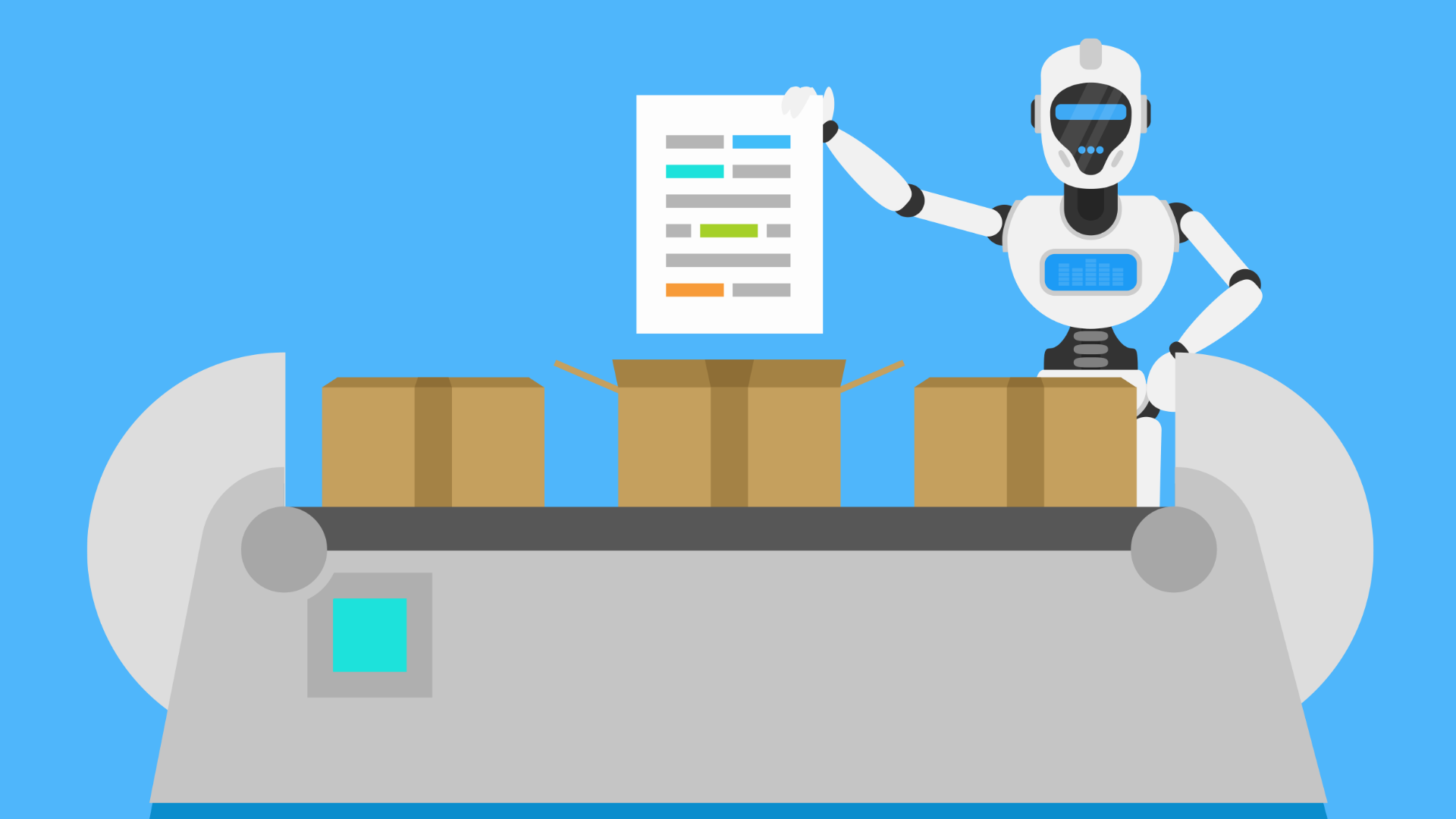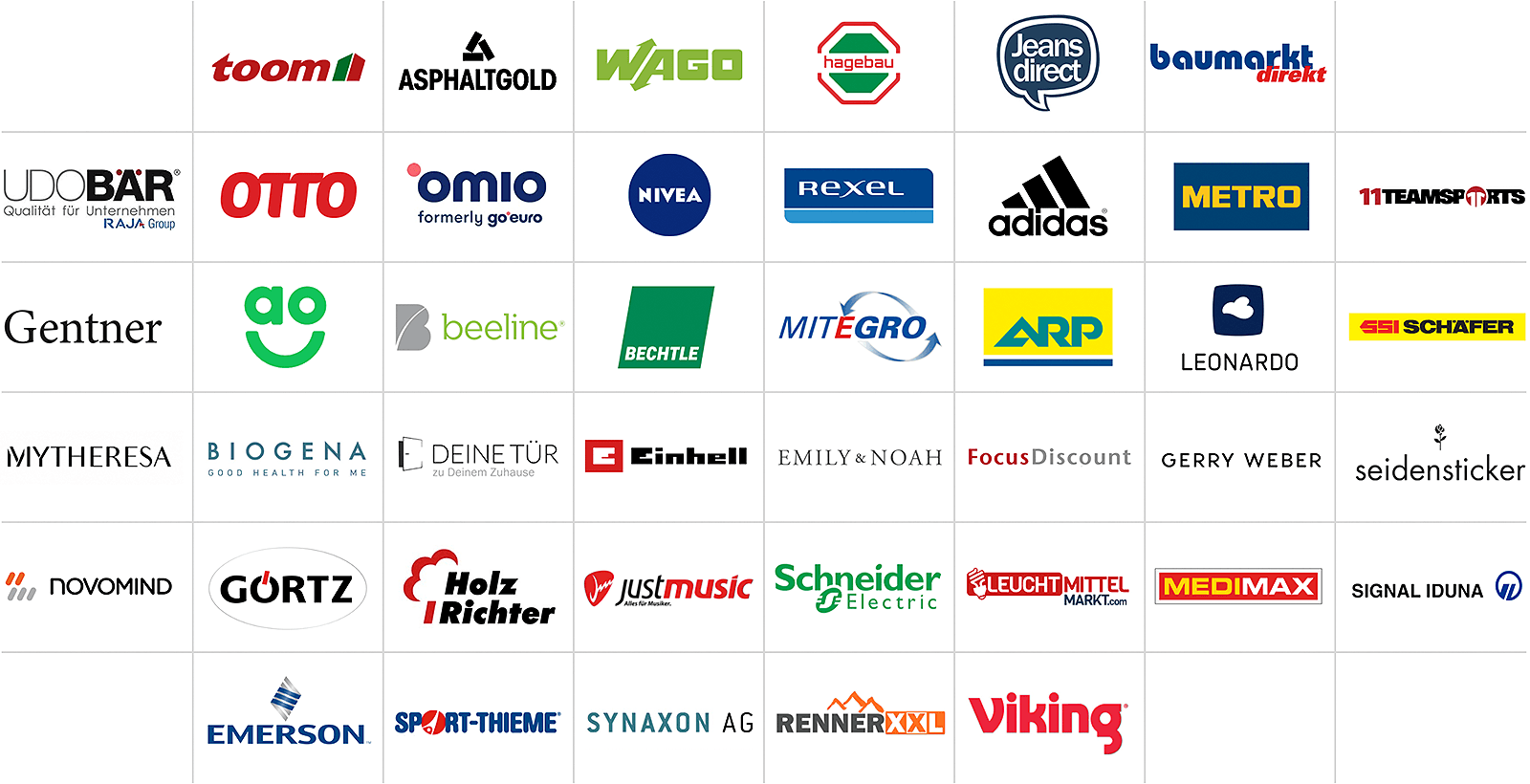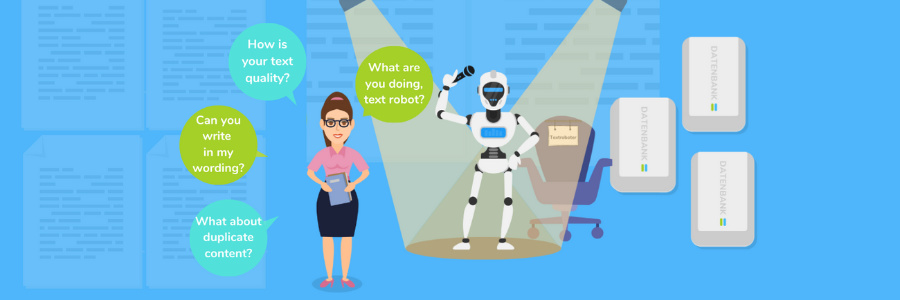Our hero in the background: The text robot currently creates 40 million texts per month. Today we’d like to introduce you to it in person and show you what it can do. To do so, we invited the robot to our studio for an interview. Since our text robot is very concerned about its privacy, there is unfortunately no recording. But we don’t want to deprive you of the conversation (in written form).
Would you rather watch a video about it? Our CEO Christian Meyer presented all the contents of the interview in a webinar. You can find the recording at the end of this article.
So: clear the stage for the text robot!
A short profile
Name: Text Robot
Year of birth:2015
Origin: uNaice
Languages: 110
Dream job: automated text generation
Current job:automated text generation
Favorite task: writing unique texts
Favorite meal: structured data

A normal working day of our text robot.
To make it easier for you to follow us, we have divided the different topics. Here you can click directly to the topics that are interesting for you:
Contents
- Interview I: What are you abel to do, text robot?
- Interview II: Frequently asked questions
- What really distinguishes content automation?
- What does uNaice do?
- The text robot in use by our customers
- Webinar: text robot in 30 minutes
What are you able to do, text robot?
Christian: Hello dear text robot! It’s nice that you found the time to chat with us. It’s something else when you talk about your work yourself.
Text Robot: Hello, thank you very much! I’m happy to be here, and I’m eager to hear your questions!
Christian: Then let’s start straight away – what is particularly interesting for our readers is how you support your colleagues in the various companies in which you are already employed. So I’ll just ask straight out: What can you actually do?
Text Robot: Oh, we’re jumping right into the topic! I’d rather stay a bit superficial here first, so that the whole thing is also understandable for those who have not yet dealt with content automation. Therefore: In principle, I can create all texts that someone wants from me. That is the basis, I should say. Beyond that, I can adapt my created texts individually and very precisely to the circumstances.
Christian: That still seems a bit abstract. What would that look like in concrete terms?
Text Robot: Let’s take you as an example, dear Christian. You run an online store for kitchen appliances and have commissioned me to write texts for your channels, such as your online store and Amazon. No sooner said than done. The products are all online, sales are ongoing. But after a while you notice that the return rate for – what can people buy from you?
Christian: I sell kitchen appliances.
Text Robot: Great! Then the return rate is remarkably high for a certain refrigerator. A look at the return slips tells you: the fridge is too noisy for a kitchen. It would have to go in the basement. For your customers, this is an enormously important piece of information that is still missing in the texts. It’s usually too much work to go out and add this additional information to all refrigerator models.
Christian: Let’s say I have 127 models. That’s quite a lot, right? With two channels, that would be 254 texts, right?
Text Robot: Exactly. Then you would have to go now, look for all 254 texts, insert this small sentence and import them again. Would you do that?
Christian: Oh, I don’t know. That’s so much effort! Then I’d rather put up with the return rate.
Text Robot: This is often the case. Understandable! Now I come back into play: all my texts are based on data that is compiled and displayed appropriately for each product. Therefore, it is easy to adapt all texts in a short time: for this, I only need to add a few nice formulations. I’ll do the rest for you. Nice, isn’t it?
Christian: Yes, wonderful, indeed! But what’s the catch?
Text Robot: *laughs* No catch, just a very elementary basis: properly structured data. Only with them is it possible for me to fill every single text with exactly the desired content.
A small addendum at this point: You can read about how exactly this works in our article on rule-based text generation.
Christian: Okay. But you certainly have your limits, don’t you?
Text Robot: Doesn’t everyone have them? But I understand what this question is aiming at. I don’t rewrite existing texts because they don’t contain structured data. Those are really elementary for me. However, I accept compromises when such data is available in structured texts. But we would have to discuss that individually.
Christian: Alright, thank you for your frankness! Let’s take a little break and then I’ll ask you some of our most frequently asked questions.
Frequently asked questions: quality and possibilities
Christian: Welcome back! Let’s not waste any time and jump right in with the first question. Text robot, how is the quality of your texts? Can one tell that they were written by a machine?
Text Robot: Try before you buy, right? Try it out yourself with a round of Bot or Not . I don’t think you’ll be able to tell which text was created by a human and which by a robot. We had a study done at LMU Munich specifically for this purpose. The result: the expertise and credibility of computer-generated texts were significantly better than those of manually generated ones.
Christian:But why is that?
Text Robot: Very simple. The quality of our text robot does not differ from the first text even with the 7543987894th text. It remains the same and at the same time rich in variation – which is not possible at all with humans.
Christian: Suppose I want to create a table or insert links – do I have to change that afterwards?
Text Robot: Don’t worry, you are not limited, you can use any text markup, for example in terms of markings or structure. Of course also links.
Christian: And what if I want a certain language style? When I look at the different companies and target groups. IKEA, for example, relies on the recognition value in the language.
Text Robot: Well, so far I haven’t disappointed any of my colleagues. But all joking aside. This is not a problem either. The text bases are created by human hand. All I do is match the right phrases and sentences with the relevant data. That means: All texts follow 100% the language style and ductus you have in mind.
Christian: And how does that work?
Textroboter: That is up to my uNaice colleagues – through questionnaires, an analysis of the inventory content, but also through the close exchange with our customers and quality loops.
Christian: Is there no duplicate content?
Text Robot: No. Based on a data set, I can always produce new, different texts. This prevents duplicate content from arising in the first place – a problem that arises with manufacturer texts, for example. At the same time, different content can be output for different output channels, such as Amazon, meta descriptions or social media. There is no duplicate content either.
Christian: Thank you! If I may summarize: companies that rely on your automated content are suddenly faced with a new situation. Because the texts are there and new, individual ones can be created at any time.
Text Robot: Exactly! Then a new question arises: What other output channels can be used?
Christian: That’s right! Once again, thank you so much for taking the time. You’ve provided quite a bit of clarity. I don’t want to keep you from your work. I think we can manage the rest without you.
Text Robot: My pleasure! I really enjoyed it – and a little change from work is never a bad thing, is it? Take care!

Is everything still a little too abstract?
Just arrange a demo with us – we would be happy to introduce you to the text robot in more detail. You can also take your colleagues, your department heads or the entire team with you. After all, very different questions arise at the different levels.
What really distinguishes content automation?
To what extent is text robot superior to manual texting?
Briefly:
- Return rates can be reduced.
- Comparison sites are possible.
- Structured data can be further interpreted or supplemented with individual content.
Managing Director Christian Meyer explains exactly what this looks like in our video (it’s in German):
What does uNaice do?
Then all you have to do is get the text robot and it will do the rest? It is not quite that easy. Our text robot needs the right input in the right form. Or as described in the profile above: his favorite meal is structured data.
Ideally, your product information is already available in a suitable format. If not, we will gladly take over this structuring for you. After that, a certain framework must be set in which the text robot may move (i.e. structure, wording, etc.).
We deliver exactly these sets of rules in the form of sentence templates, which contain several variants and, in addition, synonym or paraphrase containers. This allows for an incredibly high variance. If this is not necessary, fewer variants are simply created.
Once the basis is in place, the text robot can get to work and create the texts. New products can be integrated at any time. And internationalization can also be accelerated noticeably – with our text robot in a total of 110 languages. The big advantage: We do not use a machine translation process, but have the sentence templates translated by native speakers.
The text robot has already helped so many companies

Webinar: text robot in 30 minutes
You want to know more? In our webinar, we introduced our colleague in (just over) 30 minutes. Take a look and find out what it’s got to offer and, most importantly, how it can help you with your content. Do you have specific questions? Then scroll down – there you’ll find the most frequently asked questions about the text robot.


